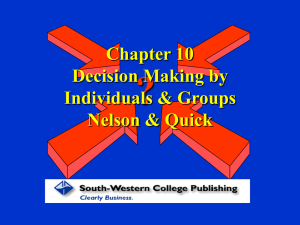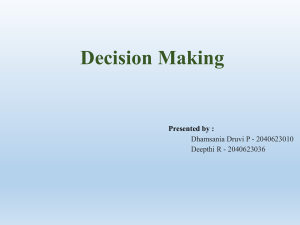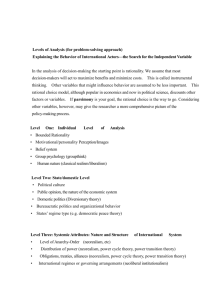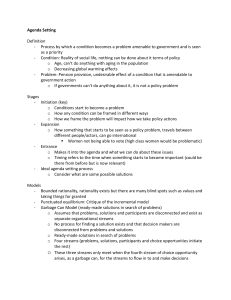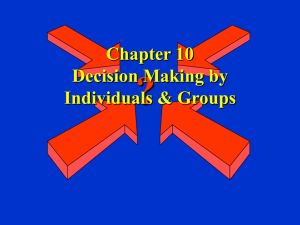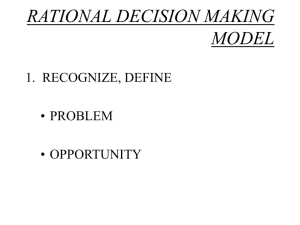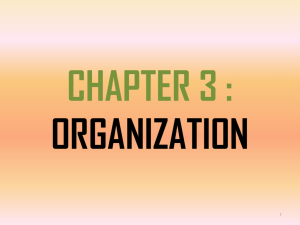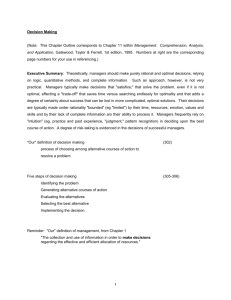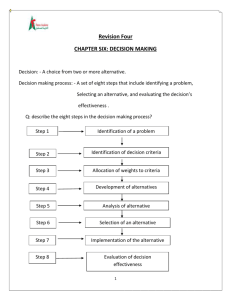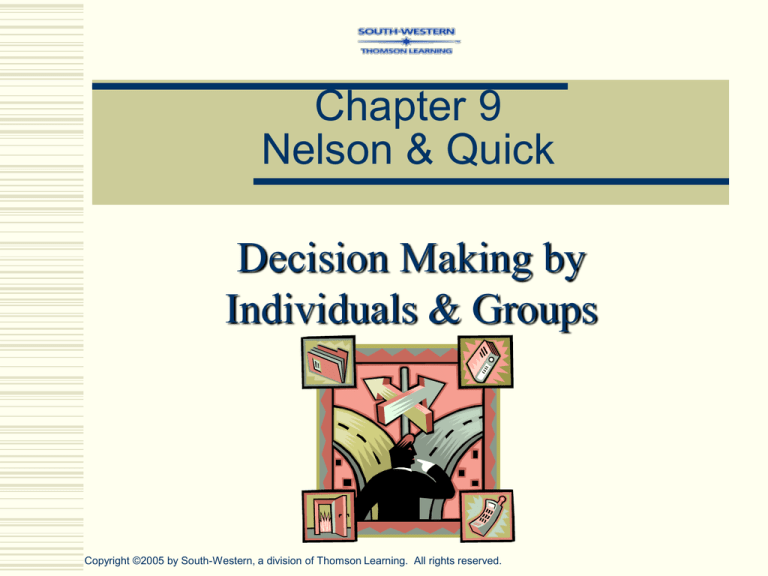
Chapter 9
Nelson & Quick
Decision Making by
Individuals & Groups
Copyright ©2005 by South-Western, a division of Thomson Learning. All rights reserved.
The Decision-Making Process
Programmed Decision - a simple, routine matter for
which a manager has an established decision rule
Nonprogrammed Decision - a new, complex
decision that requires a creative solution
The
DecisionMaking
Process
Recognize the problem and
the need for a decision
Identify the objective of
the decision
Gather and evaluate data
and diagnose the situation
List and evaluate
alternatives
The
DecisionMaking
Process
Select the best
course of action
Implement
the decision
Gather
feedback
Follow up
Models of Decision Making
Effective Decision
a timely decision that
meets a desired objective
and is acceptable to those
individuals affected by it
Rational Model
Bounded Rationality
Model
Garbage Can Model
Rational Model
Rationality - a logical, stepby-step approach to decision
making, with a thorough
analysis of alternatives and their
consequences
1. The outcome will be completely rational
2. The decision maker uses a consistent system
of preferences to choose the best alternative
3. The decision maker is aware of all alternatives
4. The decision maker can calculate the
probability of success for each alternative
Bounded Rationality
Model
Bounded Rationality - a
theory that suggests that
there are limits upon how
rational a decision maker
can actually be
1. Managers suggest the first satisfactory alternative
Satisfice – to select the first alternative that is “good
enough,” because the costs in time and effort are too
great to optimize
Bounded Rationality
Model
Bounded Rationality - a
theory that suggests that
there are limits upon how
rational a decision maker
can actually be
1. Managers suggest the first satisfactory alternative
2. Managers recognize that their conception of the
world is simple
3. Managers are comfortable making decisions without
determining all the alternatives
4. Managers make decisions by rules of thumb or
heuristics
Heuristics – shortcuts in decision
making that save mental activity
Garbage Can Model
Garbage Can Model a theory that contends
that decisions in
organizations are
random and unsystematic
Solutions
Problems
Choice
opportunities
Participants
From M.D. Cohen, J.G. March, and J.P. Olsen in Administrative Science Quarterly 17 (March 1972) 1.25.
Reprinted by permission of the Administrative Science Quarterly
Risk and the Manager
Risk Aversion - the tendency to choose options that
entail fewer risks and less uncertainty
Risk takers
accept greater potential for loss
tolerate greater uncertainty
more likely to make risky decisions
Evidence: Successful Managers Take Risks
Escalation of
Commitment
The tendency to continue to
commit resources to a failing
course of action
Why it occurs
humans dislike inconsistency
optimism
control
sunk costs
How to deal with it
split responsibility for decisions
provide individuals with a graceful exit
have groups make the initial decision
Cognitive Style
Cognitive Style - an individual’s preference for
gathering information and evaluating alternatives
Jungian theory offers a way of
understanding and appreciating
differences among individuals.
Jung’s Cognitive Style
Style
Ideal Organization
ST
Sensing/thinking
Facts/ Impersonal Analysis
SF
Sensing/feeling
Facts & Org. Relationships
NT
Intuiting/thinking
Broad Issues/Impersonal & Ideal
NF
Intuiting/feeling
Serve Humankind/General Values
Z Problem-Solving Model
Look at
the facts
and details
Can it be
analyzed
objectively?
Sensing
Thinking
What alternatives
Intuition
do the facts
suggest?
Feeling
What impact
will it have on
those involved?
Figure from Type Talk at Work by Otto Kroeger and Janet M. Thuesen. Copyright © 1992 by Otto Kroeger
and Janet M. Thuesen. Used by permission of Dell Publishing, a division of Random House. Inc.
Two Brains, Two Cognitive Styles
Left Hemisphere
Verbal
Sequential, temporal,
digital
Logical, analytic
Rational
Western thought
Right Hemisphere
Nonverbal, visuospatial
Simultaneous, spatial,
analogical
Gestalt, synthetic
Intuitive
Eastern thought
Ideal = “brain-lateralized” making use of
either or both sides, depending on situation
From Left Brain, Right Brain by Springer and Deutsch © 1989, 1985, 1981 by Sally Springer and Georg Deutsch.
Used with permission by W.H. Freeman and Company
Influences on Decision Making
Intuition - fast,
positive force in
decision making
utilized at a level
below consciousness,
involves learned
patterns of information
Creativity - a process
influenced by
individual and
organizational factors
that results in the
production of novel
and useful ideas,
products, or both
Four Stages of Creative
Process
Preparation
experience/
opportunity
to build
knowledge
base
Incubation
reflective,
often
unconscious
thought
Illumination
insight into
solving
a problem
Verification
thinking,
sharing,
testing the
decision
Influences on Creativity
Individual examples
Cognitive Processes
Divergent Thinking
Associational Abilities
Unconscious Processes
Organizational examples
Personality Factors
breadth of interests
high energy
self-confidence
Flexible organization
structure
Participative decision
making
Quality, supportive
relationships with
supervisors
Organizations Can Facilitate
Creative Decision Making
Reward creativity
Allow employees to fail
Make work more fun
Provide creativity training
Vary work groups (internal/external)
Encourage creative stimuli (music, art, etc.)
Participative
Decision Making
Individuals who are affected
by decisions influence the
making of those decisions
Organizational Foundations
Participative, supportive organizational culture
Team-oriented work design
Individual Prerequisites
Capability to become psychologically involved in
participative activities
Motivation to act autonomously
Capacity to see the relevance of participation for one’s
own well-being
Group Decision Making
Role of synergy - a positive force that occurs in groups
when group members stimulate new solutions to problems
through the process of mutual influence and
encouragement in the group
Role of social decision schemes - simple rules used to
determine final group decisions
(prediction 80% correct)
Majority Wins
Truth Wins
Two-thirds Majority
First shift
Group Decision Making
Advantages
1) more knowledge through pooling
of group resources
2) Increased acceptance & commitment due to voice in decisions
3) greater understanding due to
involvement in decision stages
Disadvantages
1) pressure in groups to conform
2) domination by one forceful
member or dominant clique
3) amount of time required, because
group is slower than individual to
make a decision
Group Phenomenon
Groupthink - a deterioration of mental efficiency,
reality testing, and moral judgment resulting from
in-group pressures
Group Polarization - the tendency for group
discussion to produce shifts toward more extreme
attitudes among members
Preventing Groupthink
Ask each group member to act as critical evaluator
Have the leader avoid stating his opinion prior to
the group decision
Create several groups to work simultaneously
Appoint a devil’s advocate
Evaluate the competition carefully
After consensus, encourage rethinking the position
From Janis, Irving L., Groupthink: Psychological Studies of Policy Decisions and Fiascoes, Second Edition. Copyright
© 1982 by Houghton Mifflin Company.
Brainstorming
Self-Managed
Teams
Dialectical
Inquiry
Quality Circles
& Quality Teams
Nominal
Group
Technique
Group
Decision
Techniques
Delphi
Technique
Devil’s Advocacy
Technological Aids to Decision
Making
Expert Systems - a programmed decision tool set up
using decision rules
Decision Support Systems - computer and
communication systems that process incoming data
and synthesize pertinent information for managers
to use
Group Decision Support Systems - systems that use
computer software and communication facilities to
support group decision-making processes in either
face-to-face meetings or dispersed meetings
Virtual Teams - groups of geographically dispersed
coworkers who work together using a combination
of telecommunications and information
technologies to accomplish a task
Group Decision
Support Systems
Tools
for
Virtual Teams
Desktop
Videoconferencing
Systems
Internet/Intranet
Systems
Ethics Check
Is it legal?
Does it violate law
Does it violate
company policy
Is it balanced?
Is it fair to all
Does it promote win–win relationships
How will it make me feel about myself

